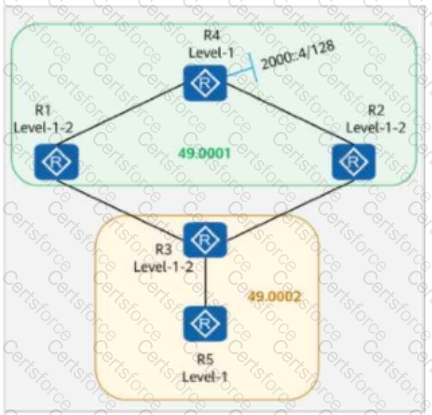Comprehensive and Detailed In-Depth Explanation:
Understanding the IS-IS Network and IPv6 Route Summary Behavior
IS-IS Areas and Router Roles:
Area 49.0001 (Level-1-2): R1, R2, R4
Area 49.0002 (Level-1-2 & Level-1): R3 (Level-1-2), R5 (Level-1 only)
Effect of ipv6 summary 2000::/64 level-1-2 Command on R4
Route summarization in IS-IS allows an L1-L2 router (R4) to aggregate IPv6 prefixes and advertise a summary route (2000::/64) into both Level-1 and Level-2 areas.
This means R4 will advertise only 2000::/64 instead of specific /128 routes (like 2000::4/128).
All Level-1 and Level-2 routers connected to R4 will receive the summary route 2000::/64 instead of the detailed /128 routes.
Route Distribution Analysis for Each Statement
A. The routing table of R1 contains the route 2000::4/128. ✅ (True)
R1 is a Level-1-2 router in the same area (49.0001) as R4, so it receives both the summarized 2000::/64 route and the more specific 2000::4/128 route.
Since R1 is directly connected to R4, it can still learn the 2000::4/128 route.
✅ Statement A is true.
B. The routing table of R3 contains the route 2000::/64. ✅ (True)
R3 is a Level-1-2 router, meaning it can receive both Level-1 and Level-2 routes.
Since R4 (a Level-1-2 router) advertises the summarized 2000::/64 route into both levels, R3 will receive 2000::/64 in its routing table.
✅ Statement B is true.
C. The routing table of R2 contains the route 2000::/64. ✅ (True)
R2 is a Level-1-2 router in the same area as R4, meaning it receives the summarized 2000::/64 route.
This is expected behavior since R4 advertises the summary route into both Level-1 and Level-2 areas.
✅ Statement C is true.
D. The routing table of R5 does not contain the route 2000::/64. ❌ (False - Correct Answer)
R5 is a Level-1 router, meaning it can only receive Level-1 routes unless a default route is provided.
Since R3 (a Level-1-2 router) learns 2000::/64, it can propagate it into the Level-1 area (49.0002).
This means R5 will receive the summary route 2000::/64 from R3.
Thus, R5 does contain 2000::/64, making this statement false.
❌ Statement D is false (correct answer).
Final Conclusion:
✅ A. The routing table of R1 contains the route 2000::4/128. (True)✅ B. The routing table of R3 contains the route 2000::/64. (True)✅ C. The routing table of R2 contains the route 2000::/64. (True)❌ D. The routing table of R5 does not contain the route 2000::/64. (False - Correct Answer)
Thus, the correct answer is: D. The routing table of R5 does not contain the route 2000::/64 (False Statement).
[Reference:, HCIP-Datacom-Advanced Routing & Switching Technology V1.0 – IS-IS Route Summarization and IPv6 Multi-Topology, Huawei Official HCIP-Datacom Study Guide – IS-IS L1/L2 Routing and IPv6 Summarization Commands, Huawei Documentation on IPv6 Route Summary Behavior in IS-IS, , , ]

Submit